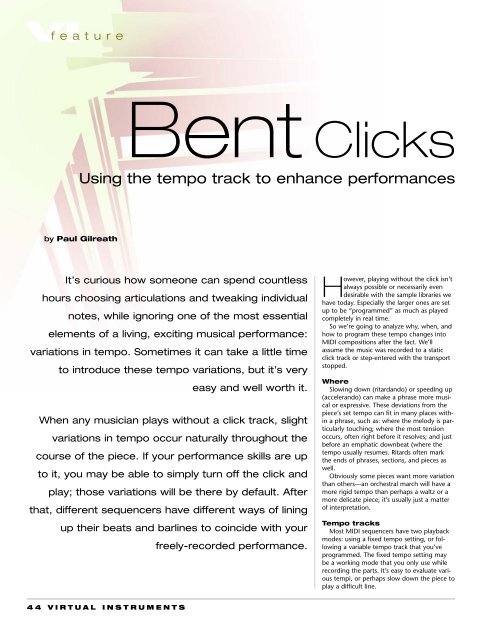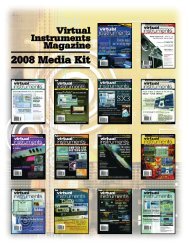Akai EWI 4000m Electric Wind Instrument Akai EWI 4000m Electric ...
Akai EWI 4000m Electric Wind Instrument Akai EWI 4000m Electric ...
Akai EWI 4000m Electric Wind Instrument Akai EWI 4000m Electric ...
You also want an ePaper? Increase the reach of your titles
YUMPU automatically turns print PDFs into web optimized ePapers that Google loves.
VI feature<br />
44 VIRTUAL INSTRUMENTS<br />
Bent Clicks<br />
Using the tempo track to enhance performances<br />
by Paul Gilreath<br />
It’s curious how someone can spend countless<br />
hours choosing articulations and tweaking individual<br />
notes, while ignoring one of the most essential<br />
elements of a living, exciting musical performance:<br />
variations in tempo. Sometimes it can take a little time<br />
to introduce these tempo variations, but it’s very<br />
easy and well worth it.<br />
When any musician plays without a click track, slight<br />
variations in tempo occur naturally throughout the<br />
course of the piece. If your performance skills are up<br />
to it, you may be able to simply turn off the click and<br />
play; those variations will be there by default. After<br />
that, different sequencers have different ways of lining<br />
up their beats and barlines to coincide with your<br />
freely-recorded performance.<br />
However, playing without the click isn’t<br />
always possible or necessarily even<br />
desirable with the sample libraries we<br />
have today. Especially the larger ones are set<br />
up to be “programmed” as much as played<br />
completely in real time.<br />
So we’re going to analyze why, when, and<br />
how to program these tempo changes into<br />
MIDI compositions after the fact. We’ll<br />
assume the music was recorded to a static<br />
click track or step-entered with the transport<br />
stopped.<br />
Where<br />
Slowing down (ritardando) or speeding up<br />
(accelerando) can make a phrase more musical<br />
or expressive. These deviations from the<br />
piece’s set tempo can fit in many places within<br />
a phrase, such as: where the melody is particularly<br />
touching; where the most tension<br />
occurs, often right before it resolves; and just<br />
before an emphatic downbeat (where the<br />
tempo usually resumes. Ritards often mark<br />
the ends of phrases, sections, and pieces as<br />
well.<br />
Obviously some pieces want more variation<br />
than others—an orchestral march will have a<br />
more rigid tempo than perhaps a waltz or a<br />
more delicate piece; it’s usually just a matter<br />
of interpretation.<br />
Tempo tracks<br />
Most MIDI sequencers have two playback<br />
modes: using a fixed tempo setting, or following<br />
a variable tempo track that you’ve<br />
programmed. The fixed tempo setting may<br />
be a working mode that you only use while<br />
recording the parts. It’s easy to evaluate various<br />
tempi, or perhaps slow down the piece to<br />
play a difficult line.



